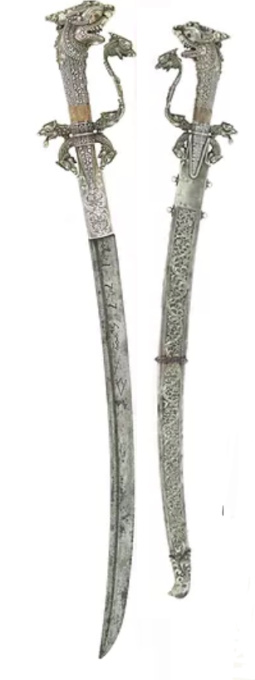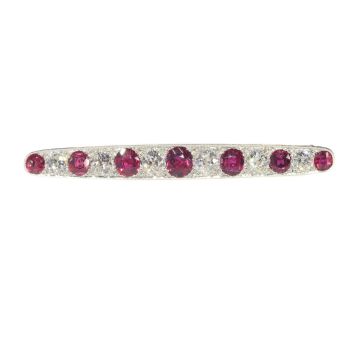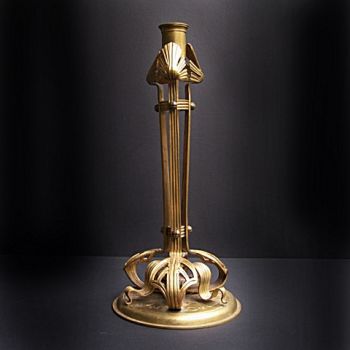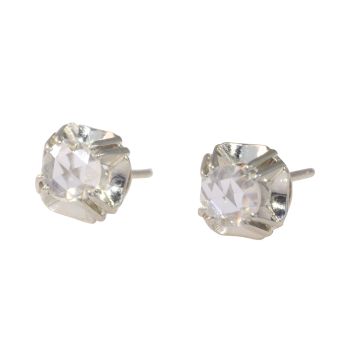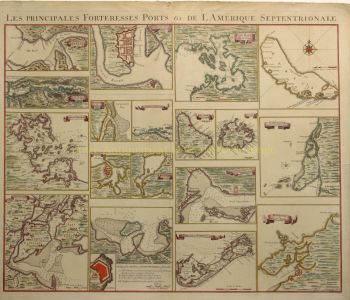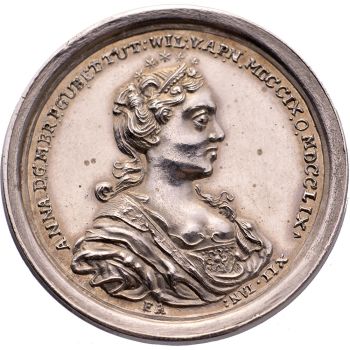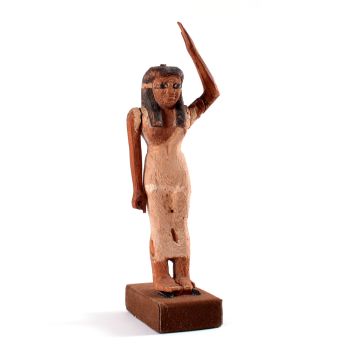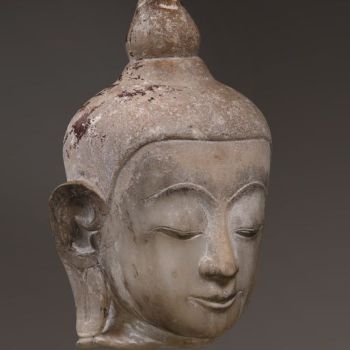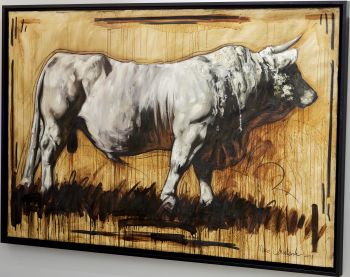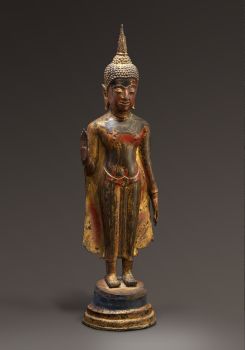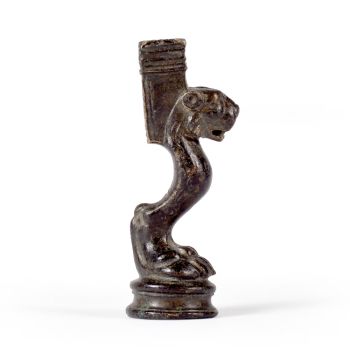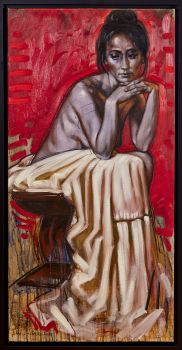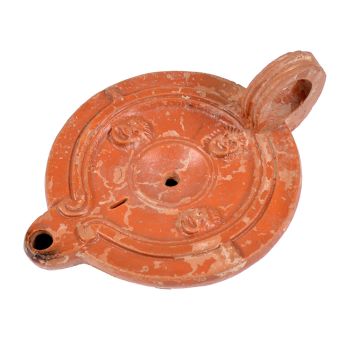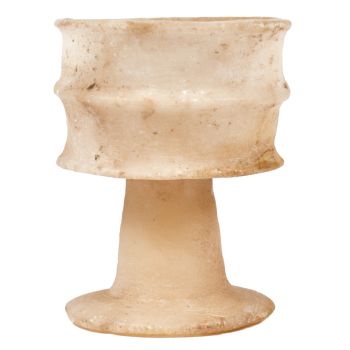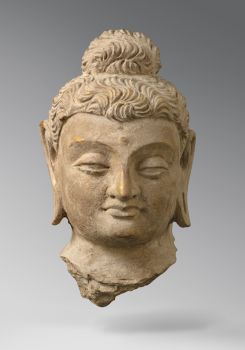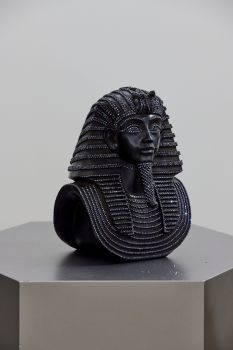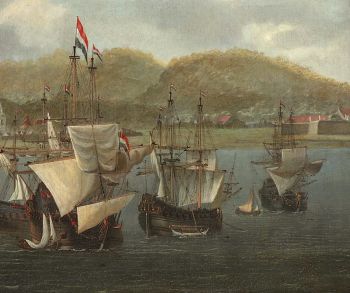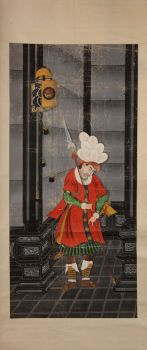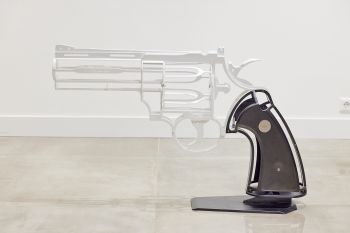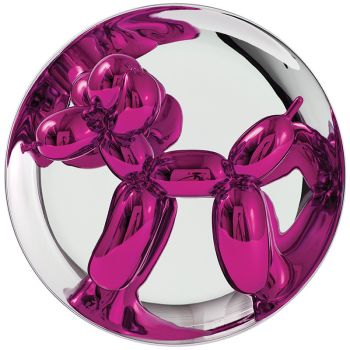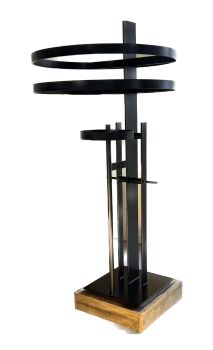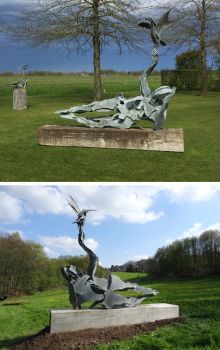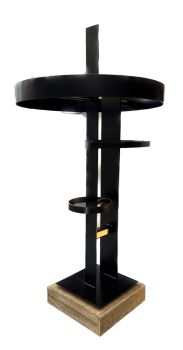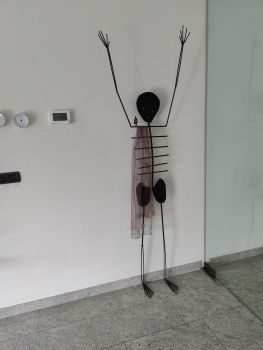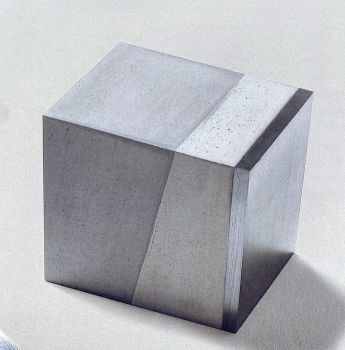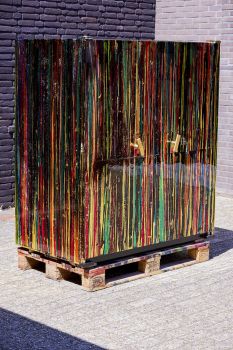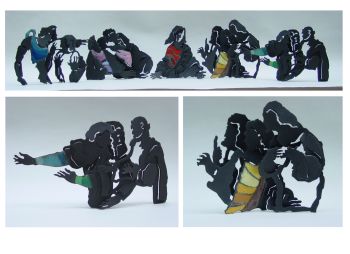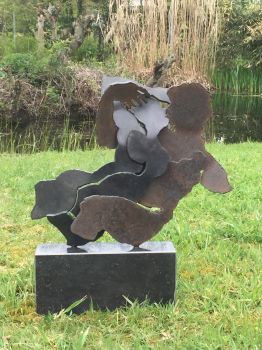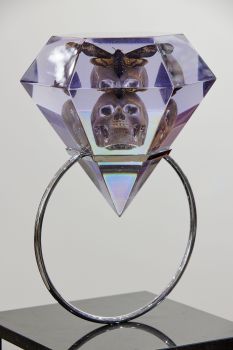A fine ruby inlaid iron, steel, silver, brass, gold Sinhalese Kasthane 1776
Artista Desconocido
HierroRubíAceroOroMetalPiedra preciosa
100 ⨯ 67 ⨯ 47 cm
Actualmente no disponible a través de Gallerease
Zebregs & Röell - Fine Art - Antiques
- Sobre la obra de arteA fine ruby inlaid iron, steel, silver, brass, gold Sinhalese Kasthane
Kingdom of Kandy, Sri Lanka (Ceylon), the blade marked VOC Amsterdam and dated 1776, the hilt late 18th century
L. 100.5 x W. 67 x H. 47 cm
A beautiful silver-mounted kasthāné with a narrow, curved blade with a single groove on each side. The blade bears the V.O.C. Amsterdam cipher on either side, with the year 1776. Many such marked blades are found all over the former colonies, including Sumatra and Java. It is unclear how they were obtained, as the V.O.C. was not officially selling the blades in these areas. Unlike many highly ornamental kasthāné that are purely ceremonial, this blade is a decent piece capable of actual use.
The silver hilt is typical Sinhalese. Cast out of two halves and worked to finer detail with chiselling in traditional Sinhalese motifs, with remains of parcel gilding. It has the large simha (lion) head pommel with ruby pupils set in gilt copper eyes. The grip is articulated with cutouts for the fingers, leading up to an octagonal gilt copper ferrule.
The crossbar terminates in a sérapéṅdiya on one side, the other side has a makara head from which the knucklebow emerges, which in turn ends in another sérapéṅdiya head. On the front of the knucklebow is a figure of Lakshmi, goddess of abundance and fortune. She is sat in the lotus position, holding two sprays of vegetation. Above the guard section emergy two makara heads, they neck leading their heads back towards the base of the blade.
The wooden scabbard is clad in silver, worked in repousse with traditional Sinhalese liya-vela, a decorative repetitive vegetal motif that sprouts from the head of a sérapéṅdiya near the tip. The scabbard endpiece is a highly stylized bird's head, with liya-pata, Sinhalese traditional curly elements.
The scabbard has a band in the middle beset with 13 pink rubies. Near the mouthpiece is engraved ".A:M.", repeated in the knucklebow. Possibly the initials of a previous owner. By the late 18th century, the western script was adopted in Sri Lanka as well, and male names often started with an A so it could have well been the initials of a local. The scabbard has four loops by which it was attached to a sash worn diagonally over the body.
A very nice example of a classic Sinhalese kasthāné of the silver type that was presented by the king of Kandy to Adigar at their appointment. It has the rare and desirable additions of a band of rubies on the scabbard and a dated, V.O.C. marked blade that put it firmly in the 18th century. In addition, there are initials that may help a future owner in further investigating the sword's context. - Sobre el artista
Puede suceder que un artista o creador sea desconocido.
Algunas obras no deben determinarse por quién está hecho o por (un grupo de) artesanos. Algunos ejemplos son estatuas de la Antigüedad, muebles, espejos o firmas que no son claras o legibles, pero también algunas obras no están firmadas en absoluto.
También puedes encontrar la siguiente descripción:
•"Atribuido a …." En su opinión, probablemente una obra del artista, al menos en parte.
•“Estudio de….” o “Taller de” En su opinión, una obra ejecutada en el estudio o taller del artista, posiblemente bajo su supervisión
•“Círculo de…” En su opinión, una obra del período del artista que muestra su influencia, estrechamente asociado con el artista pero no necesariamente su alumno.
•"Estilo de …." o “Seguidor de…”. En su opinión, una obra ejecutada al estilo del artista pero no necesariamente por un alumno; puede ser contemporáneo o casi contemporáneo
•"Manera de …." En su opinión una obra al estilo del artista pero de fecha posterior
•"Después …." En su opinión, una copia (de cualquier fecha) de una obra del artista
•“Firmado…”, “Fechado…” o “Inscrito” En su opinión, la obra ha sido firmada/fechada/inscrita por el artista. La adición de un signo de interrogación indica un elemento de duda.
•“Con firma…”, “Con fecha…”, “Con inscripción…” o “Lleva firma/fecha/inscripción” en su opinión la firma/fecha/inscripción ha sido añadida por alguien que no es el artista
¿Está interesado en comprar esta obra de arte?
Artwork details
Related artworks
Artista Desconocido
UN NETSUKE DE MARFIL DE UN HOLANDÉS CON UNA COCKEREL18th century
Precio a consultarZebregs & Röell - Fine Art - Antiques
1 - 4 / 12Artista Desconocido
The bell of the VOC fortress in Jaffna, Sri Lanka1747
Precio a consultarZebregs & Röell - Fine Art - Antiques
 curada por
curada porDanny Bree
1 - 4 / 16Artista Desconocido
Japanese transition-style lacquer coffer 1640 - 1650
Precio a consultarZebregs & Röell - Fine Art - Antiques
Artista Desconocido
Holandeses en miniatura18th century
Precio a consultarZebregs & Röell - Fine Art - Antiques
Shiba Kokan
Pintura de un holandés de fantasíaearly 19th
Precio a consultarZebregs & Röell - Fine Art - Antiques
Artista Desconocido
UN INUSUAL PLATO DE PLATA CON LOBBED INDONESIOlate 17th
Precio a consultarZebregs & Röell - Fine Art - Antiques
1 - 4 / 24Henk Visch
‘I see, I understand, I know, I remember, I do’1991
Precio a consultarGalerie Mia Joosten Amsterdam
1 - 4 / 24Artista Desconocido
UN PEQUEÑO NETSUKE DE MARFIL DE UN HOLANDÉS CON UN TAMBOR1750 - 1800
Precio a consultarZebregs & Röell - Fine Art - Antiques
Artista Desconocido
Japanese transition-style lacquer coffer 1640 - 1650
Precio a consultarZebregs & Röell - Fine Art - Antiques
 curada por
curada porDanny Bree
Artista Desconocido
Holandeses en miniatura18th century
Precio a consultarZebregs & Röell - Fine Art - Antiques
1 - 4 / 12

